Have you ever wondered how a small grebe swallows a crayfish with all those annoying legs and pincers sticking out? The answer is… it doesn’t. It amputates them first.
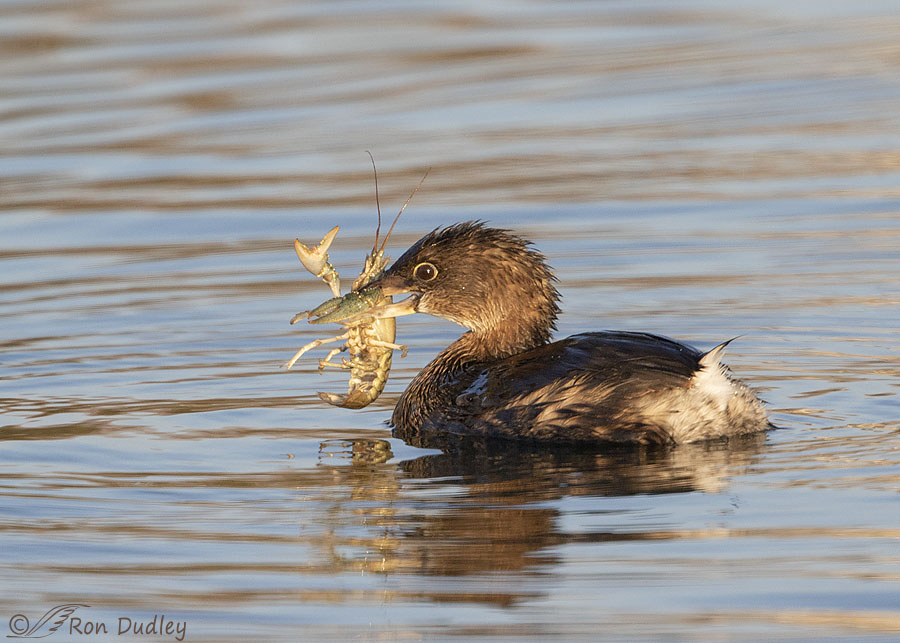
1/1250, f/6.3, ISO 500, Canon 7D Mark II, Canon EF 500mm f/4L IS II USM + EF 1.4 III Extender, not baited, set up or called in
Two days ago at one of several local ponds I frequent I spent time with this Pied-billed Grebe as it worked at swallowing a crayfish. “Crawdads” have many relatively large appendages that would seriously hinder the swallowing process so the grebe removes them before the crayfish goes down the hatch.
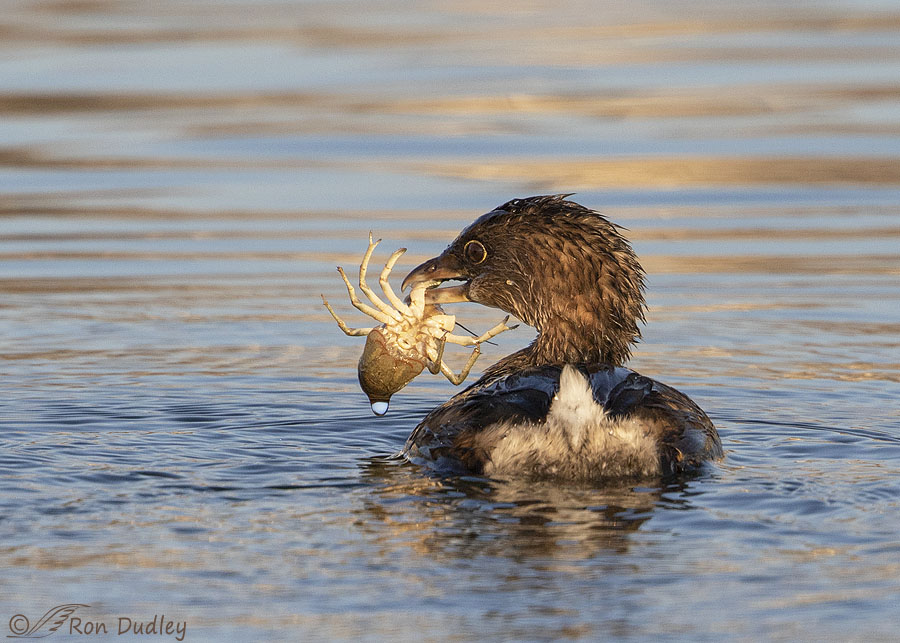
1/1250, f/6.3, ISO 500, Canon 7D Mark II, Canon EF 500mm f/4L IS II USM + EF 1.4 III Extender, not baited, set up or called in
I cropped tightly on this next photo so we can see the appendages better. Crayfish have five pairs of walking legs with the front pair having a large pincer at the terminal end. The grebe amputates them by grasping a leg in its bill and violently shaking the crayfish which usually amputates the leg at one of its joints. When that happens the crayfish often goes flying through the air.
Here we can’t see the two large anterior pincers because one of them has already been removed (we can see it’s stump) and the other one is behind the grebe’s bill. A split second after this shot was taken the grebe shook the crayfish violently and amputated the pincer.
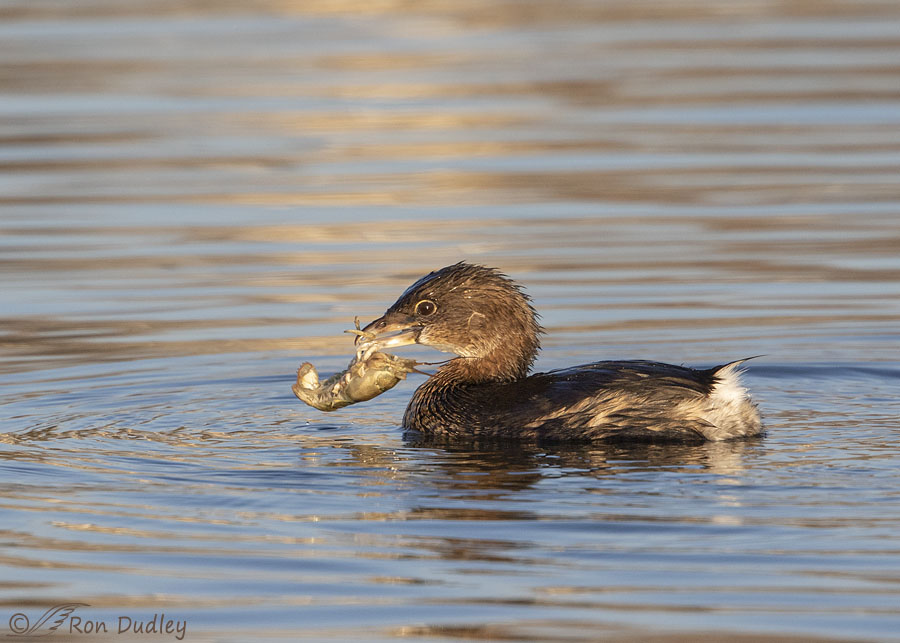
1/1250, f/6.3, ISO 500, Canon 7D Mark II, Canon EF 500mm f/4L IS II USM + EF 1.4 III Extender, not baited, set up or called in
A few seconds later both pincers and most of the other walking legs were gone. I haven’t included any of those removal photos because the grebe mostly turned its back to me during the process. At this point the grebe only had two or three more legs to remove before it swallowed the crayfish.
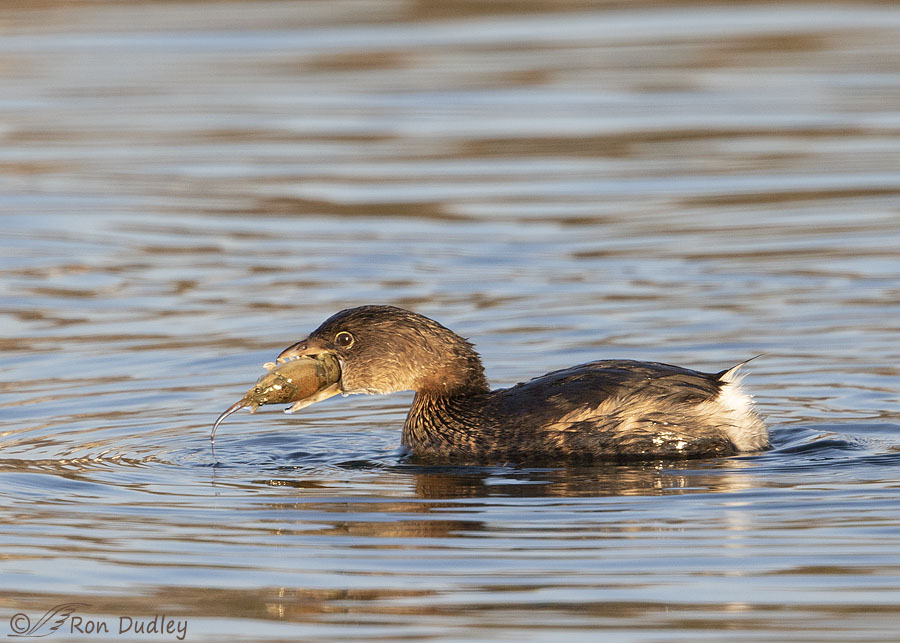
1/1000, f/6.3, ISO 500, Canon 7D Mark II, Canon EF 500mm f/4L IS II USM + EF 1.4 III Extender, not baited, set up or called in
Then it went down the hatch. Here we can see the stumps of all five walking legs on the right side of the crayfish.
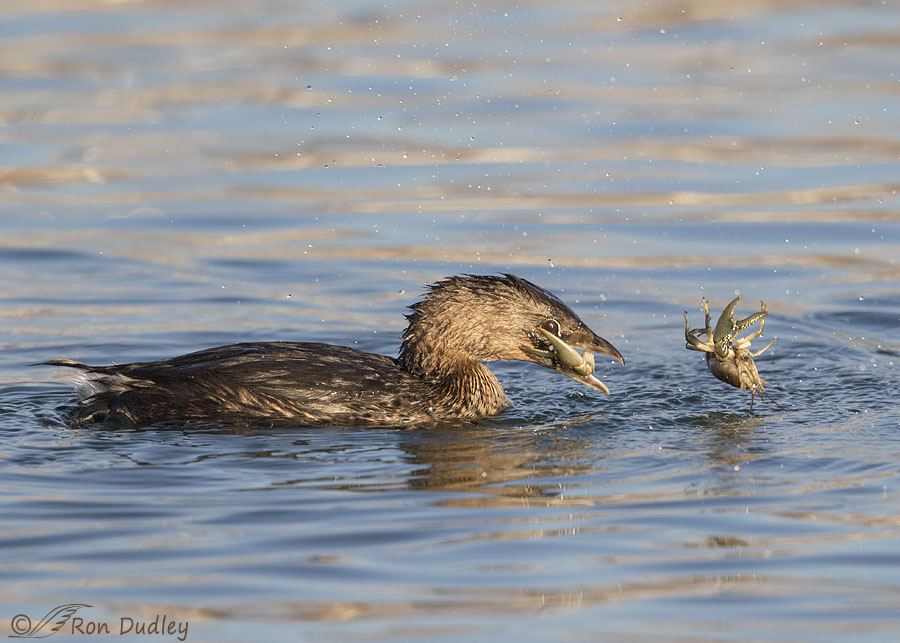
1/2500, f/6.3, ISO 800, Canon 7D Mark II, Canon EF 500mm f/4L IS II USM + EF 1.4 III Extender, not baited, set up or called in
This older photo of a different grebe shows the moment of amputation of one of the large pincers. The grebe held the anterior walking leg in its bill, shook violently, and the rest of the crayfish went flying through the air as the pincer remained in the grebe’s mouth. Amputation accomplished.
In my experience Pied-billed Grebes always remove the two large pincers and all or most of the smaller walking legs before they swallow the crayfish. The reason they do it so reliably should be obvious.
Photographing the process is great fun for the photographer with quick reflexes and a camera with a fast burst rate but each amputation happens very quickly so you have to pay attention and really be on your toes.
Ron
Note:
Amputating that many walking legs takes some time and they usually do it while on the surface so marauding gulls or other birds with kleptoparasitic tendencies often try to steal the crayfish. That’s an interaction that’s very challenging for the photographer to get photos of but I always try to be ready for it if it happens.


Wonderful photos. I have never seen a grebe regurgitate have you?
Nope, never have. But BNA says they do it effortlessly and very quickly. No retching involved.
Of course they do. Great series, and it would be an amazing thing to watch.
Thanks, EC. It was.
Wow! So cool! I do love crawdads – a bar in Austin TX had crawdads laid out on the tables during happy hour. If you bought a drink you could eat as many as you wanted! I got a lot out of my diet cokes! This series was fascinating and the other comments also. The drop of water on the crawdad in the 2nd picture is exquisite. I too wonder if they poop the shell or cough it up!
“I too wonder if they poop the shell or cough it up.”
Beth, see my response to Everett below for the answer to your question.
That sounds like a fun happy hour at that bar!
Well, yeah, that’s how we delimb the crawdads where I come from. . after we take the legs off, we eat the crawdads. Course, we generally boil them first, and if you haven’t done, you ought to try crawdad pie, with a nice cold beer.
I’ll take your word about crawdad pie, Martha. I’ll admit it might be good but it would have to be me who cleaned the little buggers before eating them. I know too much about their anatomy to take any chances about what I’m eating…
Biology kind of ruins your appetite.
Although I occasionally see a pied-billed grebe take a crayfish (“Crawdad” is the term I grew up with back in New England.), mostly I see hooded mergansers going through this process. Perhaps that’s because I photograph more along the So. Platte River than in ponds, where hoodies are less common. The process, however, is the same, with one exception. If one hoodie catches a crayfish, others often shamelessly try to steal it. They’re at least as bad as the gulls! The chase often goes weaving in and out among geese and other water birds present. You’d think with that heavy load, the chaser would easily overtake the one with prey. Not so. I’ve rarely seen a hoodie loose it’s meal to another. I might add, there’s no chivalry here, males chase females with prey as often as chasing males, unless it is an apparently mated pair.
Nancy, Pied-billed Grebes do the same thing. In fact the thief or intended thief is at least as likely to be another grebe as it is to be a different species.
What an interesting series. I love learning things, but as usual, learning new things also brings up more questions. In this case, I’m wondering about their digestive capabilities. Raptors form castings, ejecting what cannot be digested–things like the exoskeleton. Mariah, for example, has occasionally caught and eaten critters with exoskeletons and to my surprise, the outer part is contained in her casting intact–everything but the life part. So that begs the question, does the grebe digest the exoskeleton or eject it later? GADS but I love learning new things even though that process opens up a slew of new questions!
As for eating crawfish, if you spend any time in Louisiana, crawfish are on the menu. Those little mud bugs are quite tasty, and if you’re not a Cajun, you don’t have to suck the guts. That said, it’s a lot of work to get to the good parts, but a good crawfish etufee is well worth the trouble! Trust me on this!
Thank you, Laura. Regarding your question, see my response to Everett’s comment below.
Great series! KNOW those “crawdad” big pincer CAN pinch – kids playing….. Wondered how often one “gets away” or gets snatched by something else… Lots of “roughage” there.
Wondered how often one “gets away” or gets snatched by something else… Lots of “roughage” there.  Great opportunity to capture the behavior.
Great opportunity to capture the behavior.
I’ve been pinched by them too, Judy. A big one can get your attention that’s for sure.
They get “snatched by something else” fairly often. These little grebes are very wary when they have prey and if another bird makes the attempt the grebe will dive with the prey and try to swallow it underwater. But if it can’t swallow it down there gulls in particular have learned to wait for them to resurface and then snatch it away.
Regarding the “roughage”. I’ve never seen a grebe swallow one of the legs, even those with big meaty pincers, after it’s been removed. With the legs the ratio of meat to roughage must be too small. Not so with the rest of the body.
Another fascinating behavior you’ve documented. Thanks for sharing this. I admit to having felt a bit squeamish while scrolling down but then thought of the way we devour crayfish by boiling them alive and sucking out their innards.
Lyle, I’ve never eaten crayfish. That may be due to the fact that as a biology teacher I’ve dissected hundreds of them and I know what I’d get in my mouth when I was “sucking out their innards”…
‘Food Prep Series—Pied-billed Grebe Style, How to Pluck Your Crayfish.’ What a great series to have captured. Did not know they did this but it makes perfect sense. Sort of reminds me of the Grasshopper Sparrow…they grasp the grasshopper and shake the legs off prior to feeding them to their young. We do what we have to. Thanks for sharing!
Kathy, anyone who’s held a grasshopper in their hand and felt those backward-pointing spurs on their legs would understand why many songbirds remove the legs before eating the rest of the ‘hopper.
I’ve seen them swallow a fish that I would have bet No Way. They have a long neck and the fish was gone in no time.
Steven, the size of the fish they can swallow is surprising but more than once I’ve seen them take on “more than they can chew” and abandon the fish because it’s too big to swallow.
I didn’t know about the self inflicted crayfish amputations nor the fact that multiple amputations can happen at the same time. That makes me feel much better!
Good!
Must be an absolutely horrible experience for the Crayfish. “one leg gone, another leg gone, and another……..” Ten separate amputations. Just can’t image! .
.
Sorry, just had to throw in an anthropogenic twist! Love the post but for some reason I went to the Crayfish’s perspective rather than the Grebs.
Frank, there isn’t always 10 separate amputations because they sometimes remove two or more of the smaller legs at the same time. But I know what you mean. It can’t be a lot of fun for the crayfish.
On the other hand crayfish often do their own amputations. If one large pincer is damaged in a fight or for some other reason the crayfish will pull it off with the other pincer so it’ll grow back more quickly.
Outstanding photography Ron, and what an educational series. I once observed one catch a crayfish, but did not have the patience to stay with it as it struggled with its prey. So glad you did and what an amazing series to see. I saw a male Goldeneye catch and then just swallow one once and wondered what an amazing digestive system they must have. Nature is truly remarkable. Thanks for sharing this.
“what an amazing digestive system they must have”
I often think about that too, Everett. Crayfish exoskeletons are made of undigestible chitin that is regurgitated as pellets at a later time.
Regurgitation of a pellet happens very quickly. On two occasions I have seen Pied-billed Grebes come to the surface to cast a pellet. They simply spit it out with no effort involved and if you are not watching when it happens, you will easily miss it. The “pellet” is hardly a pellet if you are thinking about owl pellets. It is loose and not large and the bird simply spits it out and goes on its way. Pied-billed Grebes often come only partially to the surface before re-diving to forage for more. Each time I saw the pellet ejected, the bird came fully to the surface. I also one watched a grebe simply bite a crayfish in two right behind the last pair of legs. It grabbed the tail end and let the rest fall away. I suspect it was in a hurry because a Double-crested Cormorant was quickly swimming in its direction and it might simply have been easier to grab what it could and dive away from the cormorant.
Dan, the way you describe pellet casting in Pied-billed Grebes perfectly matches what BNA Online says about them.